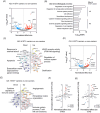The TREM2 H157Y variant is associated with more severe neurodegeneration in Alzheimer's disease and altered immune-related processes
- PMID: 40960087
- PMCID: PMC12441928
- DOI: 10.1002/alz.70586
The TREM2 H157Y variant is associated with more severe neurodegeneration in Alzheimer's disease and altered immune-related processes
Abstract
Introduction: Multiple TREM2 variants are associated with an increased risk of Alzheimer's disease (AD). TREM2 H157Y is the only variant located at the proteolytic cleavage site that enhances TREM2 protein shedding. While this variant is associated with increased AD risk predominantly in the Chinese population, its impact on AD pathology is largely unknown.
Methods: We conducted an in-depth study integrating clinical cases, neuroimaging data, and blood proteomic data.
Results: TREM2 H157Y variant carriers with AD exhibit more severe AD pathology, more severe neurodegeneration, and more rapid clinical progression. Cognitively normal individuals carrying the variant show changes in blood proteins that are associated with neurodegeneration and inflammation. Moreover, the TREM2 H157Y variant is associated with altered immune and vascular processes irrespective of disease state.
Discussion: These findings highlight the clinical implications of the TREM2 H157Y variant and the use of blood proteomic data to investigate the effects of genetic variants on disease-related endophenotypes.
Highlights: The TREM2 H157Y variant is associated with more rapid clinical progression of Alzheimer's disease only in the presence of the apolipoprotein E (APOE) ε4 allele. The TREM2 H157Y variant is associated with neurodegeneration, irrespective of disease state. The TREM2 H157Y variant is associated with altered immune and vascular processes, irrespective of disease state. Cognitively normal TREM2 H157Y carriers show altered disease-associated blood proteins related to peripheral immune response. Blood proteomic data can be used to study the impacts of disease-associated genetic variants on disease outcomes and biological processes involved in pathogenesis.
Keywords: Alzheimer's disease; TREM2; blood biomarkers; clinical case study; genetic variant; neurodegeneration; peripheral immune.
© 2025 The Author(s). Alzheimer's & Dementia published by Wiley Periodicals LLC on behalf of Alzheimer's Association.
Conflict of interest statement
The authors declare no conflicts of interest. Author disclosures are available in the supporting information.
Figures




References
MeSH terms
Substances
Grants and funding
- HKUST16103122/Research Grants Council of Hong Kong (General Research Fund)
- HKUST16102824/Research Grants Council of Hong Kong (General Research Fund)
- JLFS/M-604/24/SIAT-HKUST Joint Laboratory for Brain Science
- 32061160472/NSFC-RGC Joint Research Scheme
- CTFCF18SC01/Chow Tai Fook Charity Foundation
- ITCPD/17-9/InnoHK Initiative and Grant of the Innovation and Technology Commission of the HKSAR Government
- AoE/M-604/16/Area of Excellence Scheme of the University Grants Committee
- T13-605/18W/Research Grants Council of Hong Kong (Theme-Based Research Scheme)
- C6027-19GF/Research Grants Council of Hong Kong (Collaborative Research Fund)
LinkOut - more resources
Full Text Sources
Medical
Miscellaneous

